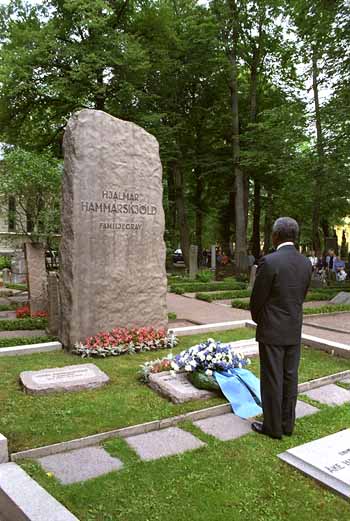By Otto Spijkers
 18 September 1961, Hammarskjold died in a mysterious plane crash as he entered the skies of what was then Northern Rhodesia, now Zambia. The Secretary-General of the United Nations was due to meet rebel leader Moise Tshombe and negotiate a truce with him in the civil war between the Katanga secessionist movement of Tshombe and the Congolese central government. There are quite a lot of theories relating to his death (see e.g. here, here, and here), but many insiders, including Brian Urquhart, believe it was just an accident. In a biography of Hammarskjold written by Urquhart, the story ends as follows:
18 September 1961, Hammarskjold died in a mysterious plane crash as he entered the skies of what was then Northern Rhodesia, now Zambia. The Secretary-General of the United Nations was due to meet rebel leader Moise Tshombe and negotiate a truce with him in the civil war between the Katanga secessionist movement of Tshombe and the Congolese central government. There are quite a lot of theories relating to his death (see e.g. here, here, and here), but many insiders, including Brian Urquhart, believe it was just an accident. In a biography of Hammarskjold written by Urquhart, the story ends as follows:
Only Harold Julien [ONUC chief of security] was alive when the search party finally reached the wreckage on the following afternoon, and he died of burns five days later. Hammarskjold was thrown clear of the wreckage and, alone among the victims, was not burned at all. Although the post-mortem showed that he had probably lived for a short time after the crash, his injuries – a severely fractured spine, several broken ribs, a broken breastbone, a broken thigh, and severe internal hemorrhaging – were certainly fatal. He was lying on his back near a small shrub which had escaped the fire, his face extraordinarily peaceful, a hand clutching a tuft of grass. (Hammarskjold, p. 589.)
In this post, I will not write about the conspiracy theories, but rather about his legacy. When Mr. Hammarskjold was installed as Secretary-General of the United Nations, he took the oath of office in the General Assembly:
I, Dag Hammarskjold, solemnly swear to exercise in all loyalty, discretion and conscience the functions entrusted to me as Secretary-General of the United Nations, to discharge these functions and regulate my conduct with the interests of the United Nations only in view, and not to seek or accept instructions in regard to the performance of my duties from any government or other authority external to the Organization.
Hammarskjold has taken his oath very seriously. In the clash between him and Nikita Khrushchev, he defended the principles of the UN Charter against superpower politics. His last Annual Report as Secretary-General (he died exactly one month after writing the report), describes the fundamental dilemma of the United Nations: must we see it as an assembly of independent states pursuing their own interests, or is it something more? This Annual Report, which is generally considered Hammarksjold’s magnum opus, is as relevant and topical today as it was in the 1960’s. In fact, it is probably even more topical today than it was back then. Hammarksjold not only lived by the Charter, he also died with the Charter. Brian Urquhart described the ‘luggage’ Hammarskjold took with him as he boarded the aircraft for what turned out to be his final journey:
Expecting to be away for just one night, Hammarskjold took only a briefcase with him, leaving everything else at Linner’s villa, including his wallet, check book [etc. etc.]. Apart from his personal effects, his briefcase contained a small extra copy of the Charter and a small English edition of the New Testament and Psalms [..]
It is well known that Hammarskjold regarded the Charter (and the Bible) as a sacred document, and that it guided him in all that he did; at the moment of his death, he had already become something of a saint for many international lawyers. One of the most emotional articles written about the consequences of Hammarskjold’s death is this one, by Oscar Schachter: Dag Hammarskjold and the Relation of Law to Politics. When you read this article, it seems as if with Hammarskjold a certain idealist conception of international law/politics died. Annan always saw Hammarskjold as his prime example (on the picture below, you see him visit Hammarksjold’s grave in Uppsala). The following is a famous quotation (it can be found here, and the entire lecture can be found here): 
His life and his death, his words and his actions, have done more to shape public expectations of the office, and indeed of the Organization, than those of any other man or woman in its history. His wisdom and his modesty, his unimpeachable integrity and single-minded devotion to duty, have set a standard for all servants of the international community – and especially, of course, for his successors – which is simply impossible to live up to. There can be no better rule of thumb for a Secretary-General, as he approaches each new challenge or crisis, than to ask himself, ‘how would Hammarskjold have handled this?’… What is clear is that his core ideas remain highly relevant in this new international context. The challenge for us is to see how they can be adapted to take account of it.
This is my last post on Dag Hammarskjold. I started at his grave, and now I end there. – Otto
